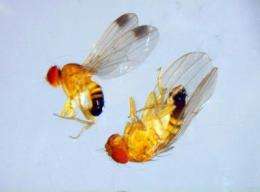An invasive Asian fly is taking over European fruit

Coming from the Asian continent, Drosophila suzukii has only been in Spain for a short time. Far away from slipping through into the Iberian Peninsula, it accelerated towards the north of Europe where it has already crossed the Alps. Amongst its preferred target are cherries and red fruits but any type of fruit is suitable for it to lay its eggs. This insect is posing a threat to the fruit of more and more European countries.
"Out of the 3,000 known species of Drosophilae, commonly named the vinegar fly, only two are potentially dangerous to fruit crops. One of them is Drosophila suzukii," assures Gemma Calabria, researcher at the Department of Genetics of the University of Barcelona (Spain).
The fly was accidentally discovered in the autumn of 2008 in Rasquera (Tarragona) and has actively or passively spread at a rate of 1,400 km per year via affected fruit transported by humans. The Drosophila has also reached Barcelona, where it was not found when first detected in Spain.
According to the study conducted by Calabria and her team, which has been published in the Journal of Applied Entomology, various regions of France and Italy have come under attack since 2009. As Calabria states, "Drosophila suzukii was discovered in the USA at the same time it was detected in Spain and it spread along the entire West coast, from California until reaching Canada. It has even been found on the East Coast, in Florida."
From the researchers' point of view, the colonisation towards the north of Europe and the American continent suggests that this species does not "especially" require a dry Mediterranean climate. "But if it spreads to more humid regions, it could cause a major agricultural epidemic," demonstrate the authors of the study.
A possible plague
Native to Asia, Drosophila suzukii was found for the first time in Japan and it is mainly characterised by the fact that the females lay their eggs in unaffected fruit. Calabria points out that "they have a large, serrated ovipositor organ that is capable of penetrating the skin of the fruit. As a result, their larvae grow inside thus destroying the fruit."
The researchers outline that since its discovery, damages to cherries and other types of berries have been reported in those countries affected. Although its favourite hosts seems to be the cherry, when it is out of season, the flies move on to other fruits.
Drosophila suzukii has caused significant damages to cherry and strawberry crops in the USA but went unnoticed in Spain for the first few years. However, it appears that in 2011 there were "major damages to different fruits" according to Institute of Agro-Food Research and Technology in Spain.
Research into the fly has allowed it to be placed on the list for phytosanitary prevention in many regions and countries throughout Europe. One of the best way to fight against the plague of flies is the use of fly traps. They allow for early detection and confirm whether the population is in growth.
The researchers advise that low quality fruit should be thrown out and infected pieces should be stored at temperatures lower than 3 to kill the eggs and larvae. This, in turn, will not compromise the quality of the fruit.
More information: Calabria, G.; Maca, J.; Bachli, G.; Serra, L.; Pascual, M. "First records of the potential pest species Drosophila suzukii (Diptera: Drosophilidae) in Europe" Journal of Applied Entomology 136(1-2): 139-147 DOI: 10.1111/j.1439-0418.2010.01583.x February 2012.
Provided by FECYT - Spanish Foundation for Science and Technology















